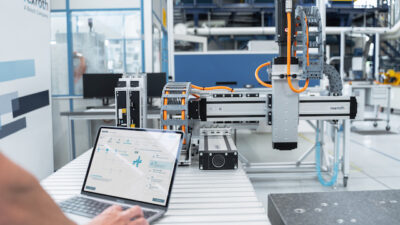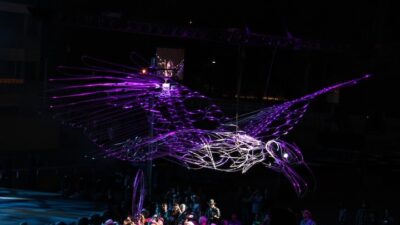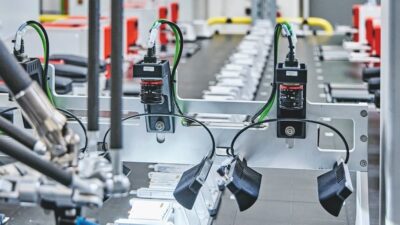The number of motion axes found in industrial automation systems has grown steadily over time because of availability of more powerful controllers and other processor advancements. Yet, in many of those systems, motion axes function independently of each other—as in indexing stations that move parts point-to-point through serial manufacturing stages or in distributed architectures with pa...
Sidebars: B&R Automation and Ethernet Powerlink Experience mild unsynchronized motion
The number of motion axes found in industrial automation systems has grown steadily over time because of availability of more powerful controllers and other processor advancements. Yet, in many of those systems, motion axes function independently of each other—as in indexing stations that move parts point-to-point through serial manufacturing stages or in distributed architectures with parallel motion paths.
In contrast, more complex automation systems require synchronization of various motion axes. A higher breed of control is required to satisfy multi-axis motion in robotic systems, printing machines, computer numerical control (CNC) machines, and high-dynamic feeders for metal forming and flying cutoff systems with line speeds of 152 m/min (500 ft/min) and more. Fast network protocols are available to implement their data transfer and control needs.
Synchronized motion control holds a special place at Baldor Electric Co. “In coordinated motion, multiple axes must work together to perform a process,” says John Mazurkiewicz, servo products manager. “This would be typical for robotics and xy/xyz-type applications where knowledge of position of other axes is needed for interpolation or kinematics.”
Baldor Electric’s multi-axis controllers and Mint software handle flying shear applications, where web material is cut to length on the fly. The shear must be accelerated cyclically to synchronize with the moving material’s speed, then decelerated for the next cut.
Baldor implements synchronized motion via its NextMove multi-axis controllers and Ethernet Powerlink (EPL)—a real-time motion control bus based on Ethernet technology. NextMove controllers can interpolate up to 16 axes, including simultaneous start/stop functions, according to Mazurkiewicz. “Number of interpolated axes is presently limited to 16 due to processing power,” he says. “In addition, NextMove e100 synchronizes servo axes (via
Baldor differentiates between synchronization, where motion axes are “clocked” from a machine reference (usually a master axis with a master encoder), and interpolation, where two or more axes are moved simultaneously on a trajectory that starts and stops at the same time. Synchronized functions include speed ratioing among axes (electronic gearing), gearing with positional offset, electronic cam profiling and flying shears. Axis interpolation can be linear, circular or higher-order type. Applications are in CNC machines, coordinate measurement systems and robotics, Mazurkiewicz explains.
Bosch Rexroth Corp. has built multi-axis synchronized motion control systems for almost 20 years, using digital fiber-optic SERCOS (serial real-time communication system) interface (IEC standard 61491), notes Karl Rapp, branch manager of the machine tool industry for the company’s Electric Drives and Controls Division. “Precise synchronization capability of SERCOS—with less than 1 microsecond jitter—has proved essential for many of today’s applications,” Rapp says. Measurements with SERCON816 chip show actual jitter as low as 0.035μs, affirming SERCOS’ usefulness to synchronize motion. Newest version SERCOS III (100 MHz Ethernet) adds performance and further I/O system capabilities.
Coordinate, synch, interpolate
Different complexity levels apply to this special motion control sector. Coordination is used where the motion path is less critical but velocity is important, as in jerk-free blended moves around obstacles at highest possible speed, according to Bosch Rexroth. (“Jerk” refers to the derivative of acceleration or third derivative of position; minimizing jerk is important to motion system performance and wear reduction.) If the program logic created by users to start and move the coordinated axes to their specified position determined velocity and acceleration ramp values from a path vector, the move will look like interpolation. However, the computation occurs only once before each move, unlike interpolation (see below), Rapp explains.
Synchronization involves “slaving” one or more axes to a master axis. This can involve a “real master,” like an encoder on a metal stamping press flywheel, or a “virtual master,” such as a registration mark or an encoder generated in the motion controller or drive. Electronic-line shafting (ELS), for example, can synchronize up to 32 axes to one master encoder and change the gear ratio of the various axes electronically, notes Rami Al-Ashqar, control product manager at Bosch Rexroth.
Interpolation —used for precise path following—is regarded as the most complex method to integrate, especially for multiple axes. A path planner or interpolator repeatedly computes the motion path vector during a move (typically at millisecond intervals). “Acceleration/deceleration and velocity vectors are derived for all participating axes for the position increment,” Al-Ashqar says. “The interpolator must look ahead to determine if axis limits might be exceeded and proactively reduce path velocity so this will not happen.”
Interpolating axes in CNC machines with response times of 0.5 ms at eight axes and 4 ms at 64 axes have set the standard at Bosch Rexroth. “Intelligent drives using SERCOS can close the position loop at 0.25 ms for highest precision and zero following error (lag),” Rapp says.
Bosch Rexroth implements synched and interpolated motion over wide applications with a SERCOS interface and various drive products—including its most recent machine tool control, IndraMotion MTX. Simpler applications, up to eight synchronized axes, call for IndraMotion MLD-M, offering cost savings for OEMs and end users by embedding a motion engine in the drive. For larger systems, IndraMotion MLC controls up to 64 motion axes.
“Precise motion path following must be implemented in the control system design and can’t just be a programmed-in feature,” Rapp adds. “Loop closure of intelligent drives must also be very rapid.”
From Rockwell Automation’s view, coordinated motion ranges from actions as simple as starting or stopping multiple axes in some synchronized fashion to complex motion path control where all affected axes must be interpolated during the move. According to Bob Hirschinger, marketing manager for Logix motion, high-performance controllers are required for these tasks, supporting one or more of the following capabilities:
Coordinate system definition—to allow grouping of axes for use with multi-axis interpolation;
Multi-axis interpolation trajectory—linear, circular, elliptical or other special interpolation on two or more axes associated with a coordinate system;
Kinematics—to control non-linear mechanical systems like joint/link robots;
Multi-axis position camming (PCAM) trajectory planner—to synchronize position and/or velocity and/or torque of multiple axes through a master-slave profile with up to fifth-order cubic interpolation (for smooth motion across path segments); and
Synchronized servo-loop closure—using an analog or digital networked drive interface, such as SERCOS.
“Applicable motion controllers support high-speed application program execution, advanced trajectory planner features and powerful functions such as registration control, dynamic path recalculation, phase offsets and more,” Hirschinger says.
Rockwell Automation offers a range of programmable automation-based controllers that support linear/circular interpolation, advanced PCAM capabilities, and various kinematic transforms. One controller handles up to 32 axes; additional synchronized axes are accommodated across multiple controllers. Other notable features include PCAM profile editing (supported by a graphical editor or tabular data input) and various kinematic transforms supported with a graphic-based configuration. Also, 40 motion instructions are available in ladder, structured text (ST), and sequential function chart (SFC) formats.
SERCOS interface connects the drives to the motion controller, which manages all trajectory path calculations, provides synchronization of axes and sends command position/velocity information to the connected drives where servo loops are closed, Hirschinger explains.
Beckhoff Automation also sees synchronized motion as a special area of control. “Motion trajectories must be calculated based on relative movements, requiring much more number crunching than controlling multiple, independent axes,” says senior engineer Robert Trask, P.E. “To simplify matters, synchronized motion is often managed with master/slave relationships—multiple slave axes moving relative to one master axis.”
Timely data exchange
With unprecedented computing bandwidth available in today’s PC platforms, control philosophy at Beckhoff focuses on ability to close position loops with one centralized industrial PC—using real-time automation software and deterministic, two-way communication with the application. “The trick is to be able to control the operating system (OS), not vice versa, and get data in and out in a fast, cyclic way,” Trask says. Beckhoff uses various Microsoft OSs and has developed its own real-time kernel to manage control-specific tasks. “The approach of running underneath the OS keeps control independent of OS processes,” he states.
Beckhoff Automation relies on its EtherCAT product, which it calls a rapidly growing technology suited to high-speed, deterministic industrial Ethernet for motion applications and also on SERCOS interface for cyclic exchange of motion data. These systems allow position-loop closure at a central industrial PC, making synchronized motion easier to manage. “Data exchange among axes, absolutely necessary for synchronization, occurs without complications from handshaking information due to multiple controllers or ‘killer latencies’ that have historically plagued synchronized motion,” Trask says.
“EtherCAT uses an elegant method to transmit data over the standard Ethernet physical layer, allowing extreme synchronization of data in the sub-microsecond range,” he continues. “This has been, at best, difficult with other industrial protocols and impossible with traditional TCP/IP.” Because EtherCAT is an IEEE-registered Ethernet-type frame, it uses standard hardware and cabling and needs no specialized network management tools. Thus, it’s also cost-effective. EtherCAT Technology Group, an open trade organization with more than 500 members, supports the protocol. A variety of vendors provide EtherCAT products.
For coordinated motion, Beckhoff uses its TwinCAT control package and software based on IEC 61131-3. TwinCAT running on a PC can control 40 to 50 coordinated axes, according to Trask.
Tuning, troubleshooting
Lee Stephens, systems engineer at Danaher Motion, mentions gantry control as another application requiring coordinated motion. Typically each side (axis) of the gantry must move in synchronism for system accuracy and repeatability. “Amount of error is less important than errors being relatively equal and of the same polarity,” he says. If not, the gantry can generate unstable oscillations while trying to move—similar to a person “walking up a ladder.” Besides inaccuracy, the resulting vibration can cause bearing damage or other system faults.
Stephens considers tuning and troubleshooting tools critical to analyze resonance, tune the system, and investigate stability without the need to change gain values one at a time to hone in on system performance. “A good oscilloscope function is now a necessity in motion controllers, especially for coordinated control,” he states.
Danaher Motion implements synchronized motion via its SynqNet real-time digital network. Axes are controlled by one Motion Supervisor so that commands generate from the same source, Stephens notes. “SynqNet’s patented phase-locked loop technology is responsible for synchronizing data streams among axes that may be operating on different clocks,” he adds. For more complex machine applications requiring larger number of motion axes and I/O points, Danaher’s SynqNet controllers such as XMP, eXMP (with embedded CPU), and ZMP enable control for up to 32 axes.
Preventing lost data or control signals because of cable degradation, electrical noise, or poor connection is crucial for minimizing error among coordinated axes. Stephens recommends logging data errors (cyclic redundancy checking), which allows analyzing and finding an axis that may have a corrupt data stream.
Siemens Energy & Automation associates the ability to synchronize multiple controllers with machine builders’ desire to produce machines serially, yet still customizable to specific user’s needs. To achieve this, builders piece together autonomous modules to make a complete machine, then synchronize the system as easily as if using just one controller, explains Zuri Evans, Simotion product manager. Siemens’ Simotion, marketed as a complete machine controller for motion applications, helps make it happen.
“Once the controllers are synchronized, Simotion allows machine builders to gear axes from one controller to any axis in any other controller with the same commands (for example, gear-on or cam-on),” Evans says. “When done right, this modular machine concept can save up to 80% in engineering time.”
Siemens recently implemented a print-finishing machine where eight Simotion drive-based controllers were synchronized for a total of 109 coordinated axes. “However, precision is just as important as axis count,” Evans adds. “For example, on a printing press, any change in synchronization during printing will turn out fuzzy images.” With less than 1 microsecond of jitter, Simotion reportedly achieves the absolute synchronization required.
More axes to come
“Real-time Ethernet-based protocols, such as Ethernet Powerlink, are opening up the number of axes that can typically be controlled from a single machine controller,” says Baldor’s Mazurkiewicz. “Powerlink can handle synchronization, interpolation or coordination with ease.” It also eases monitoring position of coordinated axes; simplifies axis synchronization (because the master encoder reference can be sent over the network rather than discretely wired from the master encoder to each drive); and aids interpolation because of the real-time nature of the network, explains Mazurkiewicz.
Bosch Rexroth—a long-standing advocate of SERCOS interface as an execution tool for complicated motion profiles in the CNC sector and other markets—sees the newest version SERCOS
Without specifying a date, Siemens mentions that its Simotion system will soon expand the concept of synchronizing multiple controllers on a single machine to synchronizing controllers on multiple machines. Siemens projects significant time and cost savings over traditional solutions by its ability to synchronize machines from various OEMs and third-party controllers communicating over Profibus or Profinet.
Rockwell Automation’s Hirschinger suggests that continued enhancements in trajectory planner technology may simplify synchronized motion control. He believes that more powerful processors will accelerate execution of complex trajectory planner and servo loop algorithms, while advanced software tools simplify development and validation of trajectory profile definition. Other near-future developments on Hirschinger’s list to watch for include advanced servo-loop algorithms implemented in drives to improve motor shaft control and advanced motion network technology, which improves ability to synchronize distributed drives—for example, timing services on Ethernet based on IEEE standard 1588.
These and other developments can provide additional tools for engineers to better coordinate, synchronize, or interpolate motion axes in their automation systems.
Author Information
Frank J. Bartos, P.E. is a Control Engineering consulting editor. You can reach him at [email protected]
B&R Automation and Ethernet Powerlink
B&R Industrial Automation Corp. is another notable advocate of Ethernet Powerlink (EPL) technology. Actually, the parent company—Bernecker + Rainer Industrie-Elektronik of Eggelsberg, Austria—was the original developer of Powerlink, having introduced it in late 2001. EPL is an industrial networking protocol said to provide deterministic, real-time data exchange via standard Ethernet.
In the 26 years since its founding, B&R has grown to international stature under its banner of “Perfection in Automation.” Today the company manufactures a broad range of automation products serving OEMs in equally wide industries. Offerings range from its high-dynamic Acopos servo drives, powerful industrial PCs, and Power Panel operator interfaces with integrated controller and visualization features to compact I/O modules (X20 & X67) and Automation Studio—a scalable programming and configuration tool applicable from simple to complex machines and processes.
B&R has applied EPL networking protocol extensively in its automation and motion-control systems to implement demanding requirements of multi-axis synchronization and interpolation. EPL claims cycle times as low as 100 microsecond (
To better promote EPL’s advantages for real-time networking, B&R transferred rights of the protocol to the Ethernet Powerlink Standardization Group (EPSG), an independent association founded in mid-2003. Now EPSG claims a following of some 200 machine builders and a 400-member user and vendor organization. Current efforts of EPSG include widening Powerlink applications beyond drives and motion control.
For more information, visit
Experience mild unsynchronized motion
Application requirements ultimately decide whether an automation system’s motion axes must be synchronized or coordinated relative each other. Still, a curious example of unsynchronized motion can be found around us—in escalators and automated walkways.
While extensive safety standards and regulations cover this type of equipment, they do not address synchronization of walkway and hand rail movement. The condition is harmless and probably interests only those of us with a penchant for technical detail.
All escalators and automated walkways exhibit this asynchronism; the condition is more noticeable on longer units, as extremely long runs exacerbate it. To experience it, try this sometime when you find an automated walkway (or people mover) of some length. Stand to the right on the walkway—to promote passing etiquette—and put your right hand on the hand rail. Keep your hand and feet in place; you will soon feel the hand rail either pulling you forward or backward from the original standing position. This lead or lag condition is progressive with distance.
Let me emphasize, there is no safety hazard since one would simply let go of the hand rail (or move one’s feet) once the “stretching” exercise becomes uncomfortable. Nevertheless, one could envision this becoming a theoretical “torturer’s tool.”
Hand rail and walkway motions of escalators/people movers could be synched, but the cost-benefit of the fix would be unattractive.



